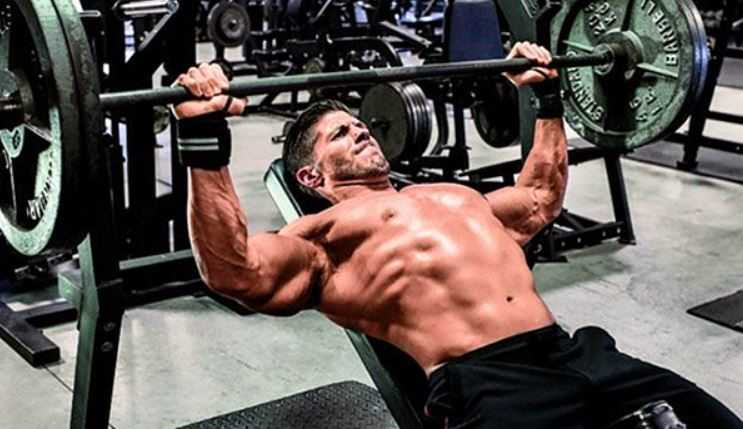Bench/dumbbell press, forms the primary movement for chest development. Its variations, which include the incline and decline bench presses are also used widely in the strength & conditioning. A common confusion prevails, as to which angle is best in the incline bench press to activate the pectorals or the chest muscles to most.

The views are many but the science is clear. Let’s see the studies involved:
- A 2016 study, compared the muscular activation of the pectoralis major, anterior deltoid and triceps brachii during a free-weight barbell bench press performed at 0deg, 30deg, 45deg and -15deg bench angles. Fourteen resistance trained males participated in this study. One set of six repetitions for each bench press conditions at 65% one repetition maximum were performed.
The results of this study support the use of a horizontal bench position to achieve muscular activation of both the upper and lower heads of the pectoralis major during both the concentric and eccentric phases of the lift.
The results suggest that an incline bench angle of 30deg is more beneficial than 45deg as it resulted in the same upper pectoralis activation but 30deg resulted in – great lower pectoralis activation. In addition, a –15deg bench did not result in greater activation of either head of the pectoralis, thus there is no added benefit of include a –15deg bench press in conjunction with a horizontal bench.
2. A 1995 study, investigated the effects of varying bench inclination and hand spacing on the EMG activity of five muscles acting at the shoulder joint. Six male weight trainers performed presses under four conditions of trunk inclination and two of hand spacing at 80% of their predetermined max.
The sternocostal head of the pectoralis major was more active during the press from a horizontal bench than from a decline bench. Also, the clavicular head of the pectoralis major was no more active during the incline bench press than during the horizontal one, but it was less active during the decline bench press. The clavicular head of the pectoralis major was more active with a narrow hand spacing. Anterior deltoid activity tended to increase as trunk inclination increased.
3. A 2017 study, compared the muscle activation of 6RM competition style bench press (flat bench-wide grip) with, 1) medium and narrow grip widths on a flat bench and, 2) inclined and declined bench positions with a wide grip. Twelve bench press athletes participated in the study. Muscle activation was measured in the pectoralis major, anterior and posterior deltoid, biceps brachii, triceps brachii and latissimus dorsi.
Non-significant differences in activation were observed between the three bench positions with the exception of 58.5-62.6% lower triceps brachii activation, but 48.3-68.7% greater biceps brachii activation in the inclined bench compared with the flat and declined bench position.
Comparing the competition bench press style (wide grip on a flat bench) resulted in similar muscle activation in chest and shoulder muscles compared with 1) an inclined and declined bench position and 2) a medium and narrow grip width. However, an inclined bench position demonstrated greater biceps, but lower triceps activation than a flat and declined bench position. Generally, the 6-RM loads were greater with a wide grip and a flat bench position, compared with the other variations of grip widths and bench positions.

4. A 2010 study, compared the activation of the clavicular head and the sternocostal head of the pectoralis major and the anterior deltoid when performing the bench press at several different angles. Fifteen healthy male subjects participated in this study. Subjects performed the chest press exercise at 0 (flat bench), 28, 44, and 56deg above horizontal using 70% of their respective 1 repetition maximum for each angle.
Activation of the clavicular head of the pectoralis major was significantly greater at 44deg compared to 0deg, at 56deg compared to 0deg, and at 44deg compared to 28deg. Activation of the sternocostal head of the pectoralis major was significantly greater at 0deg compared to 28deg, at 0deg compared to 44deg, at 0deg compared to 56deg, at 28deg compared to 56deg, and at 44deg compared to 56deg. Activation of the anterior deltoid was significantly greater at 28deg compared to 0deg, at 44deg compared to 0deg, and at 56deg compared to 0deg. To optimize recruiting, the involved musculature, it would seem that performing both the flat and incline chest press exercises is necessary.
As a conclusion, to successfully train the muscles involved in chest press exercises (sternocostal and clavicular heads of the pectoralis major along with the anterior deltoid), more than 1 angle of bench incline needs to be employed. Specifically, performing the bench press exercise at a horizontal bench position and at an inclined position of approximately 44deg (and not lower or higher) is necessary to optimally activate the entire chest musculature. The flat bench position preferentially targets the sternocostal head (commonly referred to as the lower part of pectoralis major), whereas an inclined position of approximately 44deg is required to effectively recruit the clavicular head (commonly referred to as the upper part of pectoralis major) and the anterior deltoid.
As a conclusion, one could observe that, a flat bench press activates both the upper and lower heads of the pectoralis major during both the concentric and eccentric phases of the lift. However, an incline bench angle of 30deg is more beneficial than 45deg as it results in the same upper pectoralis activation but 30deg resulted in – great lower pectoralis activation.
Also, performing the bench press an incline of app. 45deg is necessary to optimally activate the entire chest musculature. Therefore, the best angle for incline bench press would be between 30-45deg.



